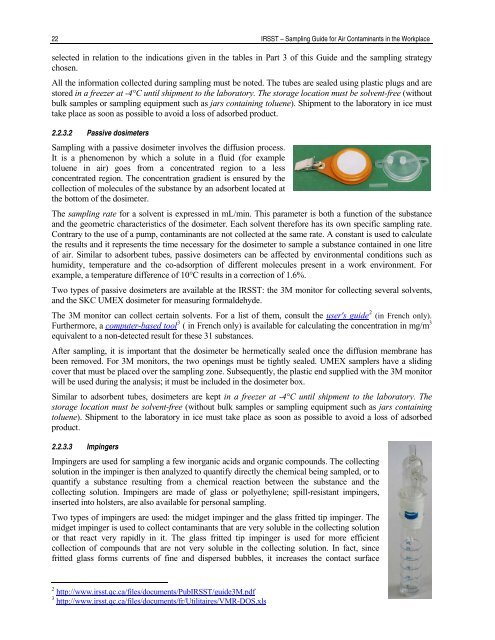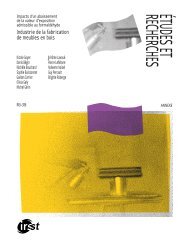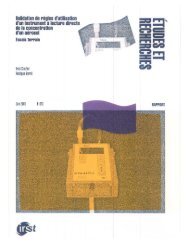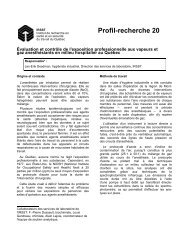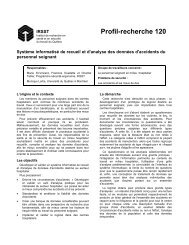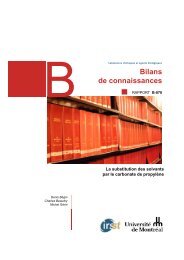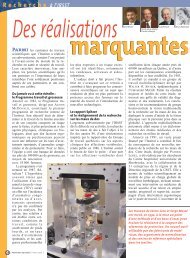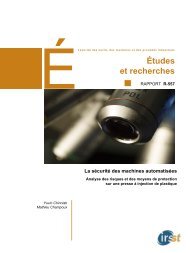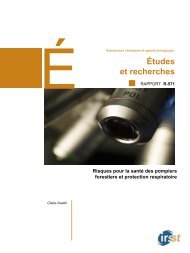Sampling Guide for Air Contaminants in the Workplace - Irsst
Sampling Guide for Air Contaminants in the Workplace - Irsst
Sampling Guide for Air Contaminants in the Workplace - Irsst
You also want an ePaper? Increase the reach of your titles
YUMPU automatically turns print PDFs into web optimized ePapers that Google loves.
22 IRSST – <strong>Sampl<strong>in</strong>g</strong> <strong>Guide</strong> <strong>for</strong> <strong>Air</strong> <strong>Contam<strong>in</strong>ants</strong> <strong>in</strong> <strong>the</strong> <strong>Workplace</strong><br />
selected <strong>in</strong> relation to <strong>the</strong> <strong>in</strong>dications given <strong>in</strong> <strong>the</strong> tables <strong>in</strong> Part 3 of this <strong>Guide</strong> and <strong>the</strong> sampl<strong>in</strong>g strategy<br />
chosen.<br />
All <strong>the</strong> <strong>in</strong><strong>for</strong>mation collected dur<strong>in</strong>g sampl<strong>in</strong>g must be noted. The tubes are sealed us<strong>in</strong>g plastic plugs and are<br />
stored <strong>in</strong> a freezer at -4°C until shipment to <strong>the</strong> laboratory. The storage location must be solvent-free (without<br />
bulk samples or sampl<strong>in</strong>g equipment such as jars conta<strong>in</strong><strong>in</strong>g toluene). Shipment to <strong>the</strong> laboratory <strong>in</strong> ice must<br />
take place as soon as possible to avoid a loss of adsorbed product.<br />
2.2.3.2 Passive dosimeters<br />
<strong>Sampl<strong>in</strong>g</strong> with a passive dosimeter <strong>in</strong>volves <strong>the</strong> diffusion process.<br />
It is a phenomenon by which a solute <strong>in</strong> a fluid (<strong>for</strong> example<br />
toluene <strong>in</strong> air) goes from a concentrated region to a less<br />
concentrated region. The concentration gradient is ensured by <strong>the</strong><br />
collection of molecules of <strong>the</strong> substance by an adsorbent located at<br />
<strong>the</strong> bottom of <strong>the</strong> dosimeter.<br />
The sampl<strong>in</strong>g rate <strong>for</strong> a solvent is expressed <strong>in</strong> mL/m<strong>in</strong>. This parameter is both a function of <strong>the</strong> substance<br />
and <strong>the</strong> geometric characteristics of <strong>the</strong> dosimeter. Each solvent <strong>the</strong>re<strong>for</strong>e has its own specific sampl<strong>in</strong>g rate.<br />
Contrary to <strong>the</strong> use of a pump, contam<strong>in</strong>ants are not collected at <strong>the</strong> same rate. A constant is used to calculate<br />
<strong>the</strong> results and it represents <strong>the</strong> time necessary <strong>for</strong> <strong>the</strong> dosimeter to sample a substance conta<strong>in</strong>ed <strong>in</strong> one litre<br />
of air. Similar to adsorbent tubes, passive dosimeters can be affected by environmental conditions such as<br />
humidity, temperature and <strong>the</strong> co-adsorption of different molecules present <strong>in</strong> a work environment. For<br />
example, a temperature difference of 10°C results <strong>in</strong> a correction of 1.6%.<br />
Two types of passive dosimeters are available at <strong>the</strong> IRSST: <strong>the</strong> 3M monitor <strong>for</strong> collect<strong>in</strong>g several solvents,<br />
and <strong>the</strong> SKC UMEX dosimeter <strong>for</strong> measur<strong>in</strong>g <strong>for</strong>maldehyde.<br />
The 3M monitor can collect certa<strong>in</strong> solvents. For a list of <strong>the</strong>m, consult <strong>the</strong> user's guide 2 (<strong>in</strong> French only).<br />
Fur<strong>the</strong>rmore, a computer-based tool 3 ( <strong>in</strong> French only) is available <strong>for</strong> calculat<strong>in</strong>g <strong>the</strong> concentration <strong>in</strong> mg/m 3<br />
equivalent to a non-detected result <strong>for</strong> <strong>the</strong>se 31 substances.<br />
After sampl<strong>in</strong>g, it is important that <strong>the</strong> dosimeter be hermetically sealed once <strong>the</strong> diffusion membrane has<br />
been removed. For 3M monitors, <strong>the</strong> two open<strong>in</strong>gs must be tightly sealed. UMEX samplers have a slid<strong>in</strong>g<br />
cover that must be placed over <strong>the</strong> sampl<strong>in</strong>g zone. Subsequently, <strong>the</strong> plastic end supplied with <strong>the</strong> 3M monitor<br />
will be used dur<strong>in</strong>g <strong>the</strong> analysis; it must be <strong>in</strong>cluded <strong>in</strong> <strong>the</strong> dosimeter box.<br />
Similar to adsorbent tubes, dosimeters are kept <strong>in</strong> a freezer at -4°C until shipment to <strong>the</strong> laboratory. The<br />
storage location must be solvent-free (without bulk samples or sampl<strong>in</strong>g equipment such as jars conta<strong>in</strong><strong>in</strong>g<br />
toluene). Shipment to <strong>the</strong> laboratory <strong>in</strong> ice must take place as soon as possible to avoid a loss of adsorbed<br />
product.<br />
2.2.3.3 Imp<strong>in</strong>gers<br />
Imp<strong>in</strong>gers are used <strong>for</strong> sampl<strong>in</strong>g a few <strong>in</strong>organic acids and organic compounds. The collect<strong>in</strong>g<br />
solution <strong>in</strong> <strong>the</strong> imp<strong>in</strong>ger is <strong>the</strong>n analyzed to quantify directly <strong>the</strong> chemical be<strong>in</strong>g sampled, or to<br />
quantify a substance result<strong>in</strong>g from a chemical reaction between <strong>the</strong> substance and <strong>the</strong><br />
collect<strong>in</strong>g solution. Imp<strong>in</strong>gers are made of glass or polyethylene; spill-resistant imp<strong>in</strong>gers,<br />
<strong>in</strong>serted <strong>in</strong>to holsters, are also available <strong>for</strong> personal sampl<strong>in</strong>g.<br />
Two types of imp<strong>in</strong>gers are used: <strong>the</strong> midget imp<strong>in</strong>ger and <strong>the</strong> glass fritted tip imp<strong>in</strong>ger. The<br />
midget imp<strong>in</strong>ger is used to collect contam<strong>in</strong>ants that are very soluble <strong>in</strong> <strong>the</strong> collect<strong>in</strong>g solution<br />
or that react very rapidly <strong>in</strong> it. The glass fritted tip imp<strong>in</strong>ger is used <strong>for</strong> more efficient<br />
collection of compounds that are not very soluble <strong>in</strong> <strong>the</strong> collect<strong>in</strong>g solution. In fact, s<strong>in</strong>ce<br />
fritted glass <strong>for</strong>ms currents of f<strong>in</strong>e and dispersed bubbles, it <strong>in</strong>creases <strong>the</strong> contact surface<br />
2 http://www.irsst.qc.ca/files/documents/PubIRSST/guide3M.pdf<br />
3 http://www.irsst.qc.ca/files/documents/fr/Utilitaires/VMR-DOS.xls


